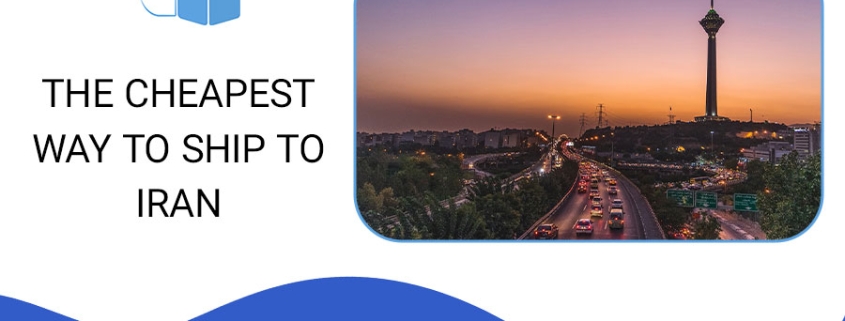The Cheapest Way to Ship to Iran
International shipping to Iran opens up exciting possibilities for sending and receiving goods across borders. However, amidst the excitement, one crucial factor often looms large: shipping costs.
In today’s global marketplace, finding cost-effective shipping methods is paramount. No one wants to spend more than necessary on shipping, especially when affordable alternatives are available.
Shipping expenses can add up quickly, impacting both personal finances and business budgets.
In this blog post, we will explore the cheapest way to ship to Iran, unraveling the secrets to making international shipping both affordable and hassle-free.
Contents
key factors influencing shipping costs to Iran
When it comes to international shipping, understanding the fundamental factors that influence shipping costs is crucial. This section will break down these factors and shed light on the common challenges people often encounter when shipping to Iran.
1. Distance
The distance between the origin and destination plays a significant role in determining shipping costs. The farther the destination, the more expensive the shipping tends to be.
For shipments to Iran, which is situated in the Middle East, you’ll likely face higher costs than neighboring countries.
2. Weight and Size
Weight and size are critical factors in calculating shipping costs. Heavier and bulkier packages typically cost more to ship.
To save on shipping to Iran, consider optimizing your packaging to reduce size and weight while ensuring your items’ safety.
3. Delivery Speed
Shipping services offer various delivery speed options, from express shipping to economy services.
Faster delivery often comes at a premium price. Opting for slower delivery can significantly cut costs if your shipment is not time-sensitive.
4. Packaging
Proper packaging is essential to protect your items during transit. However, excessive or inadequate packaging can lead to increased costs.
Choose packaging materials wisely to strike a balance between protection and cost-effectiveness.
5. Customs Regulations
Shipping to Iran involves navigating customs regulations. Understanding and complying with these regulations is crucial to avoid delays and unexpected charges.
Research the specific requirements and restrictions related to the items you’re shipping.
Common Challenges to find the cheapest way to ship to Iran

Now that we’ve covered the key factors influencing shipping costs, let’s handle some common challenges people encounter when shipping to Iran:
1. Customs Clearance
Iran has strict customs procedures, and shipments may be subject to inspections. Ensuring that your customs documentation is accurate and complete. This is vital to prevent delays and additional fees.
Be prepared to provide information about the contents and value of your package.
2. Restricted Items
Iran prohibits or restricts the import of certain items, including electronics, Drinks, and specific types of food. Check the latest regulations to ensure you’re not shipping prohibited items.
3. Political and Economic Factors
The political and economic situation in Iran can affect shipping. Changes in government policies, international sanctions, or economic conditions may impact shipping options and costs. Stay informed about current events that might affect your shipments.
4. Currency and Payment Restrictions
Iran has currency and payment restrictions that can affect international transactions. Ensure you know of any currency conversion fees or limitations when paying shipping services.
5. Documentation Accuracy
Inaccurate or incomplete documentation can lead to shipment delays or even confiscation. Double-check all forms, including commercial invoices, packing lists, and certificates of origin, to ensure they are accurate and meet Iranian customs requirements.
Understanding the basics of international shipping and the specific challenges when shipping to Iran can help you make informed decisions and minimize costs.
Consider factors like distance, weight, size, and delivery speed, and by navigating customs regulations and addressing common challenges, you can find the cheapest way to ship your packages to Iran while ensuring a smooth and reliable delivery process.
Researching for Shipping Options to Iran

When it comes to sending packages to Iran, you have several shipping options to choose from. Each option has its own advantages and considerations, making it essential to do thorough research.
Here, we’ll explore the various shipping options for cost-saving packages to Iran and highlight the importance of comparing rates and services.
1. International Couriers
International couriers such as DHL, FedEx, and UPS offer a convenient and reliable way to ship packages to Iran. They specialize in international shipments and provide several benefits:
- Speed: International couriers are known for their swift delivery times, making them suitable for time-sensitive shipments.
- Tracking: They offer advanced tracking systems that allow you to monitor your package’s journey from pickup to delivery.
- Customs Assistance: Couriers often assist with customs clearance, simplifying the process.
However, it’s crucial to keep in mind that international courier services can be relatively expensive, especially for larger or heavier packages. The convenience and speed come at a premium, so comparing rates with other options is essential to find the most cost-effective solution. Also, you should check with them if they have direct delivery in Iran.
2. Postal Services
Using the postal service, such as Iran Post, can be a cost-effective option for shipping to Iran. Here are some key points to consider:
- Affordability: Postal services typically offer more budget-friendly rates, especially for standard or economy shipping options.
- Availability: Post offices are widely accessible, making it convenient to drop off your packages.
- Varied Services: Postal services often provide various delivery speeds, including express and standard.
However, postal services may have longer delivery times than international couriers and tracking options may be limited.
It’s necessary to check the available services, delivery times, and any restrictions or requirements when using postal services for international shipments.
3. Freight Forwarding Companies
Freight forwarding companies are intermediaries that can help you ship larger and bulkier items to Iran. They offer several advantages:
- Bulk Shipments: Freight forwarders specialize in handling larger volumes and oversized items, making them ideal for businesses or individuals shipping heavy cargo.
- Customized Solutions: They can tailor shipping solutions to your needs, including sea freight, air freight, and land transportation.
However, working with freight forwarders can be more complex and involves multiple stages, including customs clearance and transportation within Iran. It’s crucial to carefully evaluate costs, transit times, and the reliability of the chosen freight forwarder.
4. Online Shipping Platforms
In recent years, online shipping platforms have become a convenient way to compare rates and services from various carriers. These platforms often partner with multiple shipping companies to offer competitive rates and comprehensive shipping solutions. Key benefits include:
- Rate Comparison: Online platforms allow you to compare rates and services from different carriers, helping you find the most cost-effective option.
- Easy Booking: You can conveniently book and manage your shipments online, saving time and reducing paperwork.
- Access to Discounts: Some platforms offer exclusive discounts or negotiated rates with shipping providers.
When using online shipping platforms, provide accurate package details and destination information for accurate rate quotes. Additionally, check customer reviews and ratings to ensure your chosen platform is reliable and reputable.
Why is it crucial to compare rates and services to find the cheapest way to ship to Iran?

1. Cost Savings: By comparing rates, you can identify the most affordable option for your shipment, saving you significant money.
2. Service Quality: Different carriers and shipping options may offer varying levels of service quality, including delivery times and customer support. Comparing services ensures you choose one that aligns with your needs.
3. Customization: Certain options may be more suitable Depending on the nature of your package and your shipping preferences.
For instance, if you need speedy delivery, an international courier might be the best choice, but if you prioritize cost, postal services or online shipping platforms may be more appropriate.
Exploring the various shipping options for sending packages to Iran allows you to decide based on your budget and specific requirements.
Whether you opt for international couriers, postal services, freight forwarding companies, or online shipping platforms, the key is diligently comparing rates and services.
This way, you can strike the right balance between affordability and reliability, ensuring your packages reach Iran safely and cost-effectively.
Factors to Consider When Choosing a Shipping Method

When shipping packages to Iran, selecting the right shipping method involves carefully considering several key factors. These factors can significantly impact your shipping costs.
Here are the specific factors to keep in mind:
1. Package Size and Weight
The size and weight of your package play a critical role in determining shipping costs. Heavier and bulkier packages generally cost more to ship. Ensure that your package is appropriately sized and packed to avoid unnecessary expenses.
- Related Article: WHAT’S THE CHEAPEST WAY OF SHIPPING LARGE PACKAGES?
2. Delivery Time Frame
Consider the urgency of your shipment. Different shipping methods offer varying delivery time frames. Suppose your package needs to reach its destination quickly. In that case, you may opt for an express service, but a slower, more economical option may be preferable if time is less of a concern.
3. Tracking and Insurance Options
Tracking allows you to monitor your package’s journey in real-time, providing peace of mind and transparency. Additionally, consider whether you want to insure your shipment. Insurance can protect your package in case of loss or damage during transit, but it may come at an additional cost.
4. Customs Regulations and Duties
Understanding customs regulations and duties is crucial when shipping to Iran. Different items may have specific import restrictions or require special documentation. Research and comply with Iranian customs regulations to avoid delays or unexpected fees.
Carefully consider these factors you can make an informed decision when choosing a shipping method for your packages destined for Iran.
If you prioritize cost-effectiveness, selecting the suitable shipping method ensures a smooth and successful delivery process.
Cost-Saving Strategies for Shipping to Iran

Shipping packages internationally can be expensive, but with some savvy strategies, you can reduce shipping costs without compromising the safety and timeliness of your shipments.
Here are five cost-saving tips:
1. Consolidating Packages:
If you have multiple items to send to Iran, consider consolidating them into a single shipment. Shipping multiple items together is often more cost-effective than sending them individually. Not only does this save on shipping costs, but it also reduces the environmental impact of shipping.
2. Choosing Slower Delivery Options:
While express shipping is speedy, it can also be expensive. If your shipment is not time-sensitive, opt for slower delivery options. Economy shipping services are typically more budget-friendly and can significantly reduce shipping costs.
3. Using Flat-Rate Boxes:
Many shipping services offer flat-rate boxes or envelopes. These packages allow you to send items at a fixed rate regardless of weight or destination. Utilizing flat-rate options can be a cost-effective choice, especially for heavier items.
4. Exploring Discounts and Promotions:
Keep an eye out for discounts and promotions offered by shipping providers. These may include seasonal discounts, bulk shipping discounts, or special rates for certain destinations.
Check shipping companies’ websites or ask local post offices for promotions.
5. Packaging Efficiently:
Efficient packaging not only protects your items but also reduces shipping costs. Use appropriately sized boxes or envelopes to minimize wasted space and weight.
Consider sparingly using bubble wrap, packing peanuts, or other protective materials to avoid unnecessary weight and volume.
By implementing these cost-saving strategies, you can make shipping to Iran more affordable while ensuring your packages arrive safely and on time.
Customs and Documentation for Shipping to Iran

When shipping packages to Iran, adhering to customs regulations and providing the necessary documentation is crucial to ensure a smooth and trouble-free delivery process.
Here are the essential customs documents you need to be aware of:
1. Commercial Invoices:
A commercial invoice is a vital document that provides detailed information about the goods you are shipping. It includes:
- Description of the items.
- Quantity and unit of measure.
- Value of each item.
- Total invoice value.
- Names and addresses of the buyer and seller.
- Terms of sale (e.g., Incoterms).
Ensure that the information on the commercial invoice is accurate and matches the details of your shipment. The declared value should reflect the actual value of the items being shipped.
2. Packing Lists:
A packing list complements the commercial invoice by offering a more detailed breakdown of the contents of each package. It includes:
- Item numbers.
- Description of items.
- Quantity of each item.
- Weight and dimensions of packages.
Providing a packing list helps customs officials verify the contents of your shipment more easily.
3. Certificates of Origin:
Certificates of origin are documents that certify the source country of the goods. These certificates may be required to determine eligibility for preferential tariffs under trade agreements.
Check if your goods qualify for trade agreements between your country and Iran that could reduce import duties.
4. Prohibited and Restricted Items:
Familiarize yourself with the list of prohibited and restricted items for import into Iran. Different countries have specific regulations regarding what can and cannot be imported.
Common examples of prohibited or restricted items might include:
- Controlled substances or narcotics.
- Weapons and firearms.
- Pornographic material.
- Certain types of electronics.
- Cultural artifacts and antiques.
Attempting to ship such items can lead to customs issues, delays, or legal consequences. Always check the latest regulations to ensure compliance.
It’s essential to work closely with your shipping provider and a customs broker to ensure your documentation is complete and accurate.
Failure to provide the necessary customs documents or inaccuracies in your paperwork can result in delays, additional fees, or even the confiscation of your shipment.
Preparing the required customs documentation is critical to international shipping to Iran. By carefully preparing commercial invoices, packing lists, and certificates of origin and adhering to regulations concerning prohibited and restricted items, you can facilitate a smooth customs clearance process and ensure that your packages reach their destination in Iran without unnecessary delays or complications.
Conclusion
Finding the cheapest way to ship to Iran is crucial for any business. Here are the key takeaways from this blog post:
- Consider package size, delivery urgency, and customs regulations when choosing your shipping method.
- Strategies like consolidation, slower delivery options, flat-rate boxes, exploring discounts, and efficient packaging can reduce shipping expenses.
- Ensure your commercial invoices, packing lists, certificates of origin, and knowledge of prohibited items are accurate and up-to-date.
- Follow a structured approach from packaging to customs clearance to ensure a smooth shipping experience.
By keeping these pointers in mind, you can navigate the complexities of shipping to Iran confidently and economically while ensuring your packages reach their destination safely.




Leave a Reply
Want to join the discussion?Feel free to contribute!